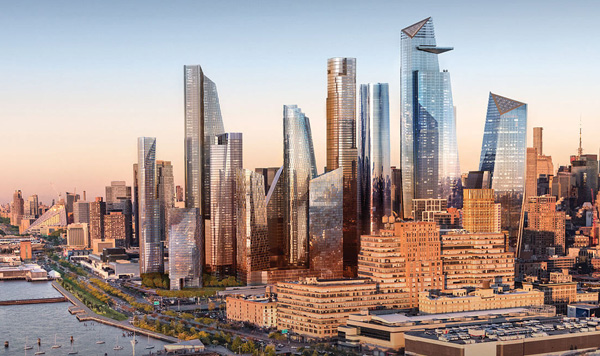Trending
It’s the economy, landlords
As job growth slows, owners may struggle to fill an influx of new office space coming to market

When BlackRock finalized a deal last year for 847,000 square feet at 50 Hudson Yards — the largest new lease of 2017 — a portion of the office space was intended for growth.
The world’s largest money manager is expanding its New York City footprint from the roughly 700,000 square feet it occupies in two Plaza District buildings. As part of a $25 million incentive package the state offered in conjunction with the deal, BlackRock pledged to create 700 new jobs in addition to paying $1.25 billion over 20 years for the lease.
And if there’s one thing Manhattan landlords need, it’s more jobs: The island is getting 12.6 million square feet of new office space in 2018 and 2019, the most in any two-year period since 1985 and 1986. And the borough’s office-using population is at an all-time high of 1.66 million, according to the state’s Department of Labor. But that, coupled with a tightening unemployment rate, means companies could find it more difficult to find qualified employees to hire, and ultimately fill Manhattan’s office buildings.
“The unemployment rate at both the national and the local level is around 4 percent,” said Ken McCarthy, Cushman & Wakefield’s chief economist. “So it’s getting increasingly difficult to add jobs, just because the economy is running out of qualified people.”
To be sure, last year saw the most leasing activity since 2014 — with 28.4 million square feet of new leases and renewals — according to CBRE. That marks an increase of 24 percent over 2016, largely due to what industry players saw as an uptick in confidence among major firms.
“Corporations feel great,” said CBRE Vice Chairman Paul Amrich, who specializes in representing landlords. “[We] feel corporate spending will continue to be robust in New York, and I think that’s why we’re seeing a lot of companies not afraid to move and invest in their space.”
Indeed, there are signs that tenants are upping their footprints rather than just playing musical chairs. Companies inked deals for 8.3 million square feet in Hudson Yards and Manhattan West last year, which is 1.3 million square feet more than those firms occupy now, according to Cushman. And a CBRE report published last spring shows that of the 123 deals inked during 2017’s first quarter, 72 percent represented an expansion.
Spotify, for example, inked a deal in February for 378,000 square feet at 4 World Trade Center, and then just five months took another 100,000 square feet. That’s on top of the 100,000-square-foot office it leases at RXR Realty’s 620 Sixth Avenue.
In December, the law firm Kirkland & Ellis signed a deal to take an extra 120,000 square feet at 601 Lexington Avenue, bringing its footprint in the former Citigroup Center to 520,000 square feet. And this year, Discovery Communications announced plans to relocate its headquarters from Maryland to New York City, which should mean more jobs for the Big Apple.
But despite all the positive news, the office market is facing headwinds in 2018.
For one, Manhattan absorption — or the ability of tenants to ink enough deals to keep up with new supply — fell last year to negative 544,000 square feet, as more supply was added in new towers on the Far West Side and Lower Manhattan, CBRE figures show.
What’s more, the efficient layouts of newly constructed buildings allow tenants to further densify their space. Companies moving into new buildings in Manhattan allocate 110 square feet per employee, compared to an average of 175 square feet across all buildings in the borough, according to JLL.
If those tenants who leased extra space expecting more growth find they don’t need it, they could dump it onto the sublease market, which would drive up the availability rate and put further downward pressure on rents. Despite record leasing activity, net effective rents have been falling for two years as landlords offered increased concessions to lure tenants. Manhattan taking rents averaged $45.45 in 2017, down 7.6 percent from 2014.
Spencer Levy, CBRE’s head of research for its Americas region, acknowledged the challenges facing Manhattan’s office market in 2018 but said there are signs to be optimistic. The Trump administration’s tax overhaul, he said, could prove to be a stimulus that pushes a late-cycle surge in the economy. In fact, the International Monetary Fund cited tax reform last month when it increased its projection for U.S. GDP growth to 2.7 percent this year and 2.5 percent in 2019.
“Those would be the most robust growth numbers we’ve seen since the global financial crisis,” Levy said. “We have an unusually robust late-cycle economy.”




